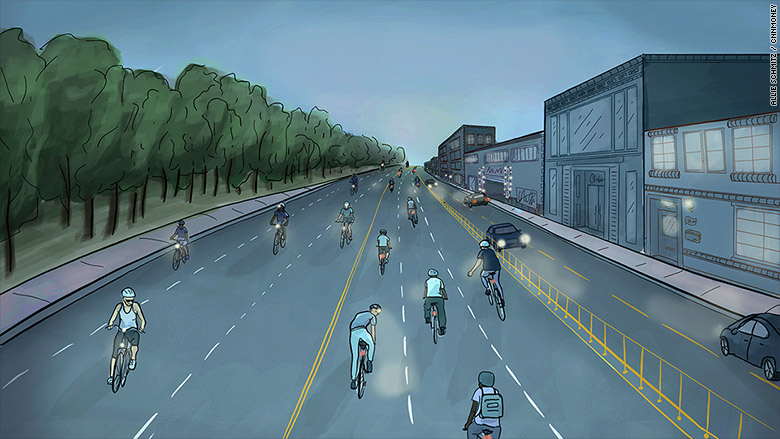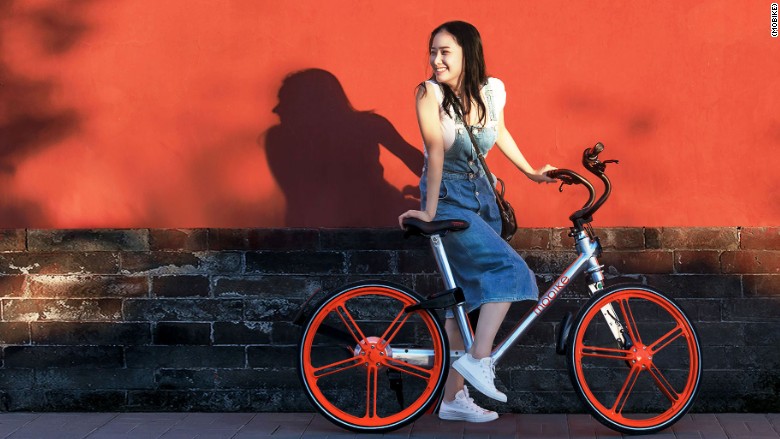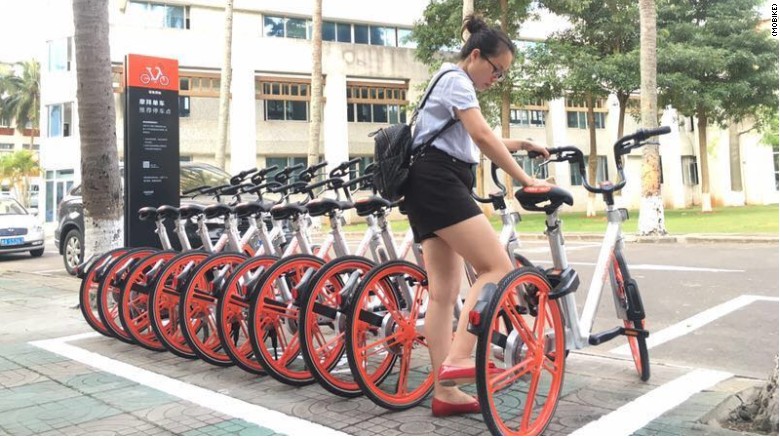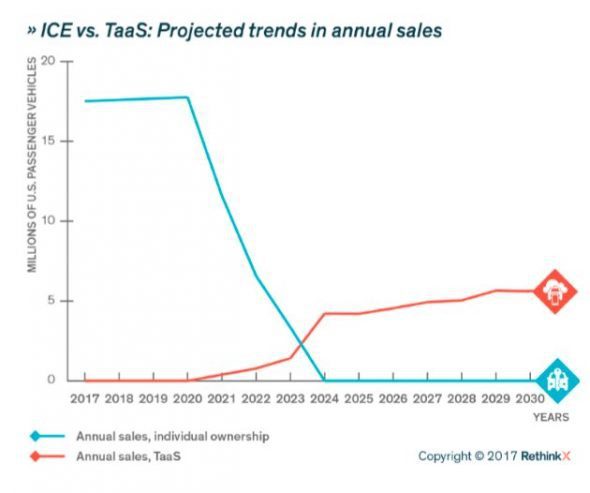Articles Menu
That's the conclusion of Horace Dediu, a prominent analyst of disruptive technologies, who has spent the past three and a half years researching the future of transportation.
Transportation is arguably the hottest frontier in the tech world. Innovators in Silicon Valley and beyond are spending billions to build flying cars and self-driving trucks. Tesla CEO Elon Musk talks of digging costly 30-level tunnel networks for cars. Google cofounder Sergey Brin reportedly has a giant airship.
But as Dediu sees it, a familiar, unglamorous technology will own the future: the bicycle. And the big loser will be cars.

"Bikes have a tremendous disruptive advantage over cars. Bikes will eat cars," Dediu told CNNTech, referencing investor Marc Andreessen's seminal 2011 argument that software-driven businesses are dominating the world.
Dediu points to the explosive growth of Chinese bikeshare systems as well as the versatility, low cost and efficiencies of shared bicycles.
Bikeshare bikes of the future, according to Dediu, will be outfitted with cameras and sensors, collecting valuable data for cities. When a cyclist rides over a pothole, it can be automatically reported to a city. Cameras on the bicycle will provide real-time data, such as pedestrian traffic and pollution. Google Street View will look like an antique compared to near real-time imagery collected from bikeshare cameras.
The bikes will need to be carefully constructed so that the cameras and sensors aren't easily broken during use.
Software and electrification are slowly transforming the auto industry. There's talk of self-driving cars flooding streets in five or 10 years. It will likely take even longer for electric vehicles to go mainstream.
Dediu argues that electric, connected bikes will arrive en masse before autonomous, electric cars. Riders will barely have to pedal as they whiz down streets once congested with cars.

Bikes' flexible nature will aid their popularity. You can park a bicycle in your home or your office. A bike can be carried on a bus, car or train. A car doesn't offer this versatility. A similar case of disruption played out with cameras, as the always-in-your-pocket nature of smartphones helped them leave traditional cameras in the dust.
Bikes have another edge on cars -- speed. New York's shared bicycles have already been shown to travel at a faster average speed than city taxis during peak hours. They're also more affordable per mile.
While the speed edge seen in New York today doesn't hold up in every city, it will likely change as electric bicycles emerge. Electric bikes -- whose motors generally top out at 20 mph -- will attract customers because they don't have to worry about breaking a sweat, struggling to climb a hill or keeping up with traffic.
"When you get on an electric bike, what we witnessed is a lot of those anxieties are calmed," said Elliott McFadden, executive director of the Austin B-Cycle, the city's bikeshare program. It recently surveyed citizens' interest in electric bikes.
"Normally if we introduce a group to bikeshare, maybe a third or half of people are interested. But almost everybody was really intensely interested in using this service," he said.
McFadden is planning a pilot program with electric bicycles in Austin. Sales are already skyrocketing in Europe.
Bikeshare systems have grown rapidly in the United States, but they aren't close to displacing cars. There needs to be a dramatic increase in bike usage for the dominance of cars to be challenged. LimeBike, a U.S. bikeshare startup, believes a key drawback today is a lack of available shared bikes.
"You look at any major or mid-sized city, they're all significantly under capacity in terms of the bikes necessary to truly change transportation habits in the public," said LimeBike vice president of strategic development Andrew Savage.

LimeBike plans to launch its first bikesharing network early this summer. It has not disclosed where. It's counting on a density of bikes and a dock-less system to help it stand out. Bikeshare networks generally require riders to return bikes to stations, which can be inconvenient. LimeBike won't have stations, so bikes can be parked anywhere. This will make transportation more fluid for riders. Bikes will be found and unlocked via a smartphone.
Related: What the next great bikeshare system will look like
By improving accessibility and convenience, bikesharing could go into hypergrowth mode. The potential is already playing out in China, where new bikeshare networks dwarf the U.S. networks in size.
America's largest programs, in New York and San Francisco, are expanding to 12,000 and 7,000 bikes, respectively.
Beijing has more than 650,000 shared bicycles. They've all appeared in the last nine months. The two heavweights of Chinese bikesharing are ofo and Mobike, which operates in more than 50 cities. Unlike most U.S. bikeshare programs, the bikes can be parked anywhere, increasing convenience for riders.
Mobike users take 20 million rides a day on the startup's 3.6 million bikes, according to the company. In the last few weeks, it's begun testing pollution sensors on some of its bicycles.

Dediu projects that there will be more than 100 million shared bicycles on global roads by 2025. According to MetroBike, there were 2.3 million shared bicycles at the end of 2016.
But there are challenges to the wide adoption of shared bicycling. Two of the biggest are infrastructure and weather.
Many potential cyclists are fearful of riding amid cars and trucks. Without protected bike lanes that shield bikes from vehicles, many people will never dare to ride a bike on a crowded street.
As Dediu sees it, first the disruptive technology arrives, then the suitable environment follows. Early roads weren't smooth enough for the first cars. Early cellular networks couldn't handle smartphone data. But with time, the world adapted to fit the promising technology. Bike lanes are already growing worldwide.
And then there's weather. Riding in the rain or snow is unpleasant. Dediu notes that the first cars and planes were open air vehicles. But they morphed into cocoons. Dediu expects bikes will follow a similar evolution.
He also expects grassroots excitement to propel the bicycle industry forward. The passion for bicycles exceeds other cutting-edge transportation projects. Surveys have shown most Americans fear riding in a self-driving car.
"I can talk until I'm blue in the face about [autonomous vehicles] and I don't get a lot of response," Dediu said. "Whenever I open my mouth about electric bicycles, the enthusiasm I get back is literally deafening."
[And for a pro-car vision of the future, from Reneweconomy.com (no mention of the energy and other inputs required or the urban sprawl that would result):
By 2030, you probably won’t own a car, but you may get a free trip with your morning coffee. Transport-As-A-Service will use only electric vehicles and will upend two trillion-dollar industries. It’s the death spiral for cars.
A major new report predicts that by 2030, the overwhelming majority of consumers will no longer own a car – instead they will use on-demand electric autonomous vehicles.
By 2030, within 10 years of regulatory approval of autonomous electric vehicles (A-EVs), the report says, 95 per cent of all US passenger miles traveled will be served by on-demand, autonomous, electric vehicles that will be owned by fleets rather than individuals.
The provision of this service may come virtually free as part of another offering, or a corporate sponsorship. Imagine, for instance, paying a token sum for a ride into town after buying a latte for $4.50. Or getting a free ride because the local government has decided to make transport easier.
The report, by RethinkX, an independent think tank that focuses on technology-driven disruption and its implications across society, says this stunning and radical will be driven entirely by economics, and will overcome the current desire for individual car ownership, starting first in the big cities and then spreading to the suburbs and regional areas.
This disruption will have enormous implications across the transportation and oil industries, decimating entire portions of their value chains, causing oil demand and prices to plummet, and destroying trillions of dollars in investor value, not to mention the value of used cars.
At the same time it will create trillions of dollars in new business opportunities, consumer surplus and GDP growth.
Lead consultant and co-author Tony Seba, who specialises in disruptive technologies. His early forecasts for the enormous uptake of solar where considered crazy, but were proved right, and he has since said that new technologies will make coal, oil and gas all but redundant by 2030).
He says while the report focuses on the US, the forecasts are valid for Australia too, because the transportation industry is global. And he warns that the car you buy now may well be your last.
“This is a global technology disruption. So yes, this applies to Australia,” Seba tells RenewEconomy. “And this is going to happen despite governments, not because of governments.
“Furthermore, the disruption will start in cities with high population density and high real estate prices – think Sydney and Melbourne then Perth, Brisbane and Adelaide – and quickly radiate out to the suburbs, the smaller cities, and then rural areas.”
Indeed, there are some people who are starting to anticipate this change, considering Australian-based business models and even local manufacturing, such as those revealed on Monday by Michael Molitor, the head of a new company called A2EmCo.
Seba does not say that individual car ownership will completely disappear. By 2030, 40 per cent of cars will still be privately owned, but they will only account for 5 per cent of kilometres traveled.
Autonomous cars will be used 10 times more than internal combustion vehicles were, they will last longer – maybe one million miles (1.6 million km) – and the savings will inject an additional $1US trillion into the pockets of Americans by 2030.
Seba admits that his forecasts are hard to digest. But what he sees in the transition to autonomous EVs from privately owned petrol cars is the same he has seen for all other major transitions: what he calls the 10x opportunity cost.
It happened with the printing press, it happened with the first Model T – it cost the same as a carriage and two horses, but offered 10x the horsepower.
“Every time we have had a ten x change in technology, we had a disruption. This is going to be no different.”
And that change, he says, will happen on day one of level 5 autonomous EVs obtaining regulatory approval. “Basically, the day that autonomous vehicles are regulatory accepted, transport-as-a-service will be 10 cheaper than cost of new vehicles,” he says. And four times cheaper than the cost of already owned vehicles.
Why is this? Because everything will be cheaper.
Like his predictions on the rise of solar, and the sudden decline of fossil fuels, Seba’s calculations are driven by simple economics. Within few years, the upfront costs of AEVs will match those of petrol cars. But the depreciation costs will be minimal, because the cars, owned by fleets, will “last a lifetime”.
Maintenance costs will be significantly lower – thanks to 20 moving parts in the powertrain compared to 2,000 for petrol cars – and the miles travelled significantly higher; they will be doing 1.6 million km by 2030, more than five times more than petrol cars.
Moreover, battery technology will improve, needing to be replaced only once, and old batteries will be able to used elsewhere (in the power grid). The cost of maintenance will be one-fifth the cost of current cars, the cost of finance one tenth, and the cost of insurance also one tenth.
“The survival of car manufacturers will depend on building cars with long lifetimes and low operating costs. This means that they will optimise for minimum waste of resources in building and operating vehicles, including designing vehicle platforms with parts that are interchangeable and recyclable.”
The report outlines the huge benefits from this transformation. Unclogging city roads, removing the pollution that is choking major cities, savings millions of lives from accidents and trillions of dollars in health impacts, and freeing up parking space.
We often forget about the health impacts of fuel cars. In 2015 in the OECD alone, outdoor air pollution lead to $US1.7 trillion annual economic cost from premature deaths. According to the World Health Organisation, 1.25 million people died from road traffic accidents around the world in that year, and another 50 million were severely injured.
“Autonomous vehicles will be safer than human drivers, leading to a decrease in road traffic accidents,” the report says. Although, to be sure, any such accidents caused by faulty software rather than humans will create huge controversy
The nature of the vehicles may also change – with a range of two-person, four-person, eight-person and even bigger vehicles in heavy population areas.
It will also have an impact on geopolitics – with the world no longer dependent on oil reserves for the bulk of its transportation needs. This will benefit big transport fuel importers like Australia.
The “politics of lithium,” meanwhile, are completely different to the politics of oil. Lithium is plentiful, although it needs planning to ensure that the mines are in place to extract it, and its demand can be reduced by recycling. Alternatives can be found for cobalt, currently found mostly in countries such as Democratic republic of Congo.
 Seba recognises that most people assume that the biggest impediments to this scenario are behavioral issues such as love of driving, fear of new technology, or just habit. The cost savings, the speed, the increased safety and the extra free time will be key factors.
Seba recognises that most people assume that the biggest impediments to this scenario are behavioral issues such as love of driving, fear of new technology, or just habit. The cost savings, the speed, the increased safety and the extra free time will be key factors.
But he says that what he calls “pre-TaaS” companies such as Uber, Lyft and Didi have also invested billions of dollars developing technologies and services to overcome these issues. In 2016, these companies drove 500,000 passengers per day in New York City alone.
“That was triple the number of passengers driven the previous year. The combination of TaaS’s dramatically lower costs compared with car ownership and exposure to successful peer experience will drive more widespread usage of the service.
“Adopting TaaS requires no investment or lock-in. Consumers can try it with ease and increase usage as their comfort level increases. Even in suburban and rural areas, where wait times and cost might be slightly higher, adoption is likely to be more extensive than generally forecast because of the greater impact of cost savings on lower incomes.
“As with any technology disruption, adoption will grow along an exponential S-curve.”